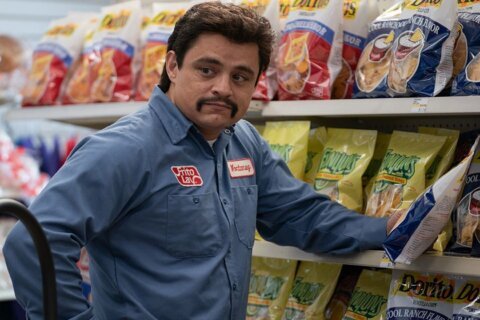WASHINGTON — From Katniss to Carell, the Hunger Games to the Olympic Games,
two highly anticipated movies hit theaters this weekend.
One is a sci-fi action three-quel from a blockbuster franchise based on
dystopian teen fiction. The other is a true-crime sports drama from a gritty
original screenplay.
Both have star-studded ensembles. Both have deadly violence. Both feature dark political
undercurrents.
Strap on your headgear. Grab your bow and arrow. We’re going to the mats.
May the odds be ever in your favor.
‘Foxcatcher’
Director Bennett Miller’s third narrative feature, “Foxcatcher,” finally
arrives here in America after wowing judges at the Cannes Film Festival, where
Miller won Best Director and the film was nominated for the prestigious Palme
d’Or.
As with “Capote” (2005) and “Moneyball” (2011), Miller once again pulls his
story from the pages of real life. But while “Capote” was adapted from Gerald
Clarke’s 1988 biography and “Moneyball” was adapted from Michael Lewis’ 2003
novel, there was no source material for “Foxcatcher.”
Instead, Miller worked with screenwriters Dan Futterman and E. Max Frye to
sculpt the story from scratch, basing the script on the headlines of wrestling
brothers Mark and Dave Schultz, who both won gold medals at the 1984 Olympics.
The movie opens with Mark (Channing Tatum) barely scraping by in rural
Wisconsin, training with Dave (Mark Ruffalo) for the 1988 Olympic Games, in
Seoul. One day, the brothers are visited by millionaire philanthropist John du Pont (Steve Carell), who
recruits them to
join him at Foxcatcher Farm, a state-of-the-art wrestling facility in Pennsylvania.
Du Pont’s eye is initially on Dave, who declines the offer so he can stay with
his family. Mark goes instead, beginning a dark journey of misguided father
figures, runaway patriotism and chilling intimidation that builds toward
certain bloodshed against the snowy backdrop of rural America.
Miller tells WTOP he cast a then-unknown Tatum eight years ago after seeing the Sundance hit “A
Guide to Recognizing Your Saints” (2006), a
performance he called “amazing” and “something closer to how he began,” before his career took a
different trajectory with “Step Up” and “21 Jump Street.”
“It was the first time I had ever heard of him. I saw the film — didn’t even
have a script yet — called him up, met with him, pitched him the movie,
offered him the part,” Miller says. “‘Step Up’ hadn’t come out yet. I thought it would be nice to cast an
obscure actor in this role and not have a big movie star. And of course, it took six years
to get made and now he’s the biggest movie star on Planet Earth.”
Famous or not, Tatum is an inspired pick. With sculpted muscles and a meathead buzz cut, he
channels the athletic intensity of Kurt Angle, the head-butting rage of DeNiro’s “Raging Bull” (1980) and
the drunken mirror smashing of Martin Sheen’s “Apocalypse Now” (1979).
The key to Tatum’s performance might just be Ruffalo, who joins him in an
opening sparring session that unfolds like a beautiful dance, the two actors
grappling, ducking and weaving across the gym.
“They complement each other so well,” Miller says. “It was really only ever
one person in my mind to play that role. It was going to be Mark Ruffalo.”
Ruffalo makes a physical transformation with a goatee and a balding scalp, but
his character’s emotions are near to Ruffalo’s own life experience, having
lost his real-life brother.
“We really had one real talk about it … and we never talked about it again,” Miller says. “But I got to
know Mark very well, and I knew when stuff was bubbling up.”
As good as Tatum and Ruffalo are together — and they are great —
“Foxcatcher” is truly a vehicle for Carell. He’s best known for side-splitting comedy in “The 40-Year-Old
Virgin” (2005) and TV’s “The Office” (2005), but we’ve seen hints of his dramatic range as the suicidal
uncle in “Little Miss Sunshine” (2006) and the jerk father in “The Way Way Back” (2013). Both of those
flicks
featured musical contributions from Rob Simonsen, who composed the eerie score
for “Foxcatcher.”
“There’s another side to (Carell) that really
does not get aired out too much. There’s a public persona that we’re all
familiar with, and there’s a private reality,” Miller says. “To be such a
public persona as Steve Carell, for your own sanity, I think you have to
maintain a good measure of privacy. It’s none of the world’s business how
complicated you might be behind the comedic mask.”
Here, Carell dons a prosthetic nose, speaks in quiet tones and displays pathetic unathleticism, showing
off for his controlling mother (Vanessa Redgrave) in an “emperor has no clothes” moment.
“When we discussed this role, he expressed a pretty deep understanding of the
character and what this film was and what it would take, as well as a
willingness to exhibit some of these qualities. Other than being an extremely
talented actor, that sort of commitment goes a long way.”
All three actors — Tatum, Ruffalo and Carell — deserve Oscar nods,
as does Miller, who’s building a reputation as an actor’s director.
In his debut “Capote,” he coached Philip Seymour Hoffman to an Oscar for Best
Actor. In “Moneyball,” he directed Brad Pitt and Jonah Hill to Oscar
nominations.
“I care, that’s all. That’s the main thing, just caring. Having the
determination to find a process. It’s different in every film with different
actors and different ensembles, just finding a process that is going to allow
these actors to be truthful,” Miller says.
More than just being an actor’s director, Miller also has a cinematic eye. He
opens the film with a symbolic fox hunt similar to Jean Renoir’s “The Rules of
the Game” (1939), but while Renoir used elaborate camera moves,
Miller mines a voyeuristic tension from mostly static shots. His camera lurks
behind trees. It watches out windows. It gazes past a symbolic stuffed fox in
the foreground.
“The film doesn’t tell the story; it observes it,” Miller says. “The lens choices and the deliberateness
with which the camera moves or does not move, as well as the sound design, the silence … all of the
different elements work to sensitize you to noticing what the characters themselves aren’t even
noticing. We are seeing something that we’re not supposed to be seeing.”
By letting his shots breathe, Miller allows our eyes to scan his frame for
symbolic mise-en-scene, like the giant American flag framed behind du
Pont’s desk. The patriotic imagery is important, as the majority of the story
takes place in the late 1980s.
“It was set in the ’80s during Reagan. It was a new ‘Morning in America,’ and
there was an idealism that people were latching onto, which was a reaction to
a bleaker reality that many were feeling,” Miller says. “The first act, with
these brothers who are Olympic champions but hardly scraping by, is sort of a
Carter-era reality, and (Tatum) is sort of airlifted into this idealism. Part
of what made this story appealing was that we didn’t have to reach for this
stuff. It was all right there. Just natural metaphor.”
Throughout the film, du Pont is painted as a greedy member of the privileged one percent.
He champions American exceptionalism, telling television cameras, “I am giving
America hope.” And if you carry this metaphor all the way to the end credits,
the final scene becomes a thumb in the eye to anyone who blindly chants “USA,
USA” at a UFC bloodsport match while ignoring the violent excesses of
patriotic hawkishness. Indeed, Miller’s worldview is on full display, which
may be why it spoke so well to the judges at Cannes amid France’s post-Iraq
distrust of American military intervention.
“Each of these films (‘Capote,’ ‘Moneyball’ and ‘Foxcatcher’), to me,
resonated with significant themes and they have an allegorical quality,”
Miller says. “They actually operate in the same way that fiction operates. For
me, good fiction is always about something bigger than the story. If it’s not
doing that, it’s just sensationalism.”
Miller certainly shies away from sensationalism — almost too much. At times, the whole exercise feels
too distant, its message lurking just beyond our grasp. It’s a character study, for sure, but the
characters’ motives are vague. Mark Schultz craves a father figure, but what about du Pont? Does he
suffer from mental illness? Suppressed homosexuality? Norman Bates mommy issues? We’re never
quite sure, making the climactic “random act of violence” all the more random.
It’s hard for audiences to embrace a film so blatantly cold and cynical. You’ll walk out so depressed that
some are calling it the “feel bad” movie of the year. If you’re going to damn the world, your characters
better have clear motives. In this regard, the script doesn’t quite hold up its end of the bargain. Still,
Miller’s direction is so masterful and the ensemble performances so phenomenal, that “Foxcatcher” will
haunt us all for months to come — all the way through awards season.
★ ★ ★ 1/2
![]()
‘The Hunger Games: Mockingjay: Part 1’
This weekend also brings the third installment of “The Hunger Games,” or shall
we say the first part of the third installment, shot all at once but released
in two parts, with Part 2 slated for November 2015.
“Mockingjay Part 1” begins where “Catching Fire” left off, with Katniss
Everdeen (Jennifer Lawrence) having shattered the games forever with a well-
placed arrow into the arena’s electrical dome.
The games are over. The war has begun.
Katniss has since been extracted to an underground bunker, where rebel leaders
Alma Coin (Julianne Moore) and Plutarch Heavensbee (Philip Seymour Hoffman)
mold her as their Mockingjay, the face of a revolution against the evil
dictator President Snow (Donald Sutherland).
They hire a team of filmmakers to film battlefield recruitment videos starring
Katniss, who shouts rallying cries for the freedom fighters.
“I have a message for President Snow,” Katniss shouts into the camera against
a backdrop of smoldering rubble. “If we burn, you burn with us!”
The fight is personal for Katniss, whose lover Peeta Mellark (Josh Hutcherson)
has been captured by President Snow and forced to produce propaganda pieces
for the Capitol, urging the rebels to lay down their arms while slamming them
with relentless airstrikes.
If this battle of promotional videos sounds like a weak plot, it’s because
“Part 1” takes the first half of Suzanne Collins’ “Mockingjay” book and
stretches it into an entire movie. Thus, Part 1 feels like one giant preamble
to the looming battle in Part 2.
Fortunately, director Francis Lawrence (no relation to Jennifer) and screenwriters Peter Craig (“The
Town”) and Danny Strong (“Game Change”) do their best within the confines of this two-part strategy. If
Hollywood is the Capitol, and President Snow is an oppressive studio exec, these filmmakers are the
fiery rebels, finding moments of real suspense, humor and inspiration, particularly as Katniss sings a
rallying song “The Hanging Tree,” adapted from Collins’ novel and put to a melody by The Lumineers.
Much of the credit belongs to the deep supporting cast, who have built a lovable
camaraderie over the past three movies. Elizabeth Banks steals the show as a
dressed-down Effie Trinket, who wages comical prisoner-of-war complaints.
Woody Harrelson uses his “True Detective” cred for a grand entrance, then
mines laughter as the alcoholic Haymitch Abernathy in a new era of
Prohibition.
Liam Hemsworth is suitably studly as Gale Hawthorne, inspiring conflicting
desires within Katniss. Jeffrey Wright is a key plot driver as the genius
computer hacker Beettee. Mahershala Ali (“House of Cards”) is a welcome addition, as is Julianne
Moore, who charms in her interactions with the late Philip Seymour Hoffman, who finished shooting his
scenes before his untimely death. What a treat.
The beating heart of this cast remains Jennifer Lawrence, who proves she’s
still the biggest blockbuster actress in the game. Her range from comedy
(“American Hustle”) to drama (“Winter’s Bone”) is unrivaled among her
contemporaries, and both shine through in “Mockingjay.” The comedy comes
during the rebel promo videos, as Katniss displays her unpolished acting skills.
The drama comes as she examines the rubble of District 12 with lip-quivering
shock.
The fact that Katniss performs this “rubble gaze of grief” multiple
times proves the danger in splitting up the final book, which is a shame considering “Mockingjay” — in
its entirety — has the potential to be the best in the series. Some fans will despise the lack of fast-paced
action compared to the first two films. After all, there are no Hunger Games in this “Hunger Games.”
But to these cinephile’s eyes, the budding rebellion against President Snow has always been more
interesting.
Not only is “Mockingjay” soaked in social commentary, it finally finds a tone that matches the serious
subject matter, unlike the previous treatment of popcorn teenage death matches. The pacing builds
quite nicely, feeling like Lawrence’s most mature work, before it slams head-first into a wall marked
Studio Money Grab. Act Three feels anti-climactic because, well, it’s supposed to be the midpoint. No
matter how inspiring the locker-room speech, we still want to see the kickoff.
This “pay now, reward later” approach is part of a troubling trend that began with “Harry Potter” (2001-
2011), a stellar film franchise, and continued with “Twilight” (2008-2012), a lame franchise which
showed just how far teen movies have fallen since the glory of “The Graduate”
(1967). This approach hit a new low with the prequel trilogy “The Hobbit”
(2012-2014), which divided one small book into three long movies. It will
hit a new low with “Avengers 3,” aptly titled “Infinity War,” the
20th sequel in the Marvel Cinematic Universe, with Part 1 in
2018 and Part 2 in 2019.
Which brings us to “The Hunger Games” (2012-2015), which has come the closest to “Harry Potter” in
capturing the political zeitgeist of our times under the guise of teen entertainment. Look no further than
Thailand, where protestors are raising a defiant three-finger salute in Bangkok to protest a military
takeover. It’s more than a pop culture phenomenon. It’s got the seeds of revolution.
With great power comes great responsibility. It’s important to get these films right. If the series is a
three-course meal, the first installment was a filling breakfast, the second was a satisfying lunch and
the third is a delicious dinner with a far superior recipe, but the portions are too small.
As Coin says to Katniss, “It’s the worst kind of
torture: waiting and knowing you can’t do anything about it.” And so, a potential 4-star entertainment is
rendered “good” instead of “great.”
Sigh.
There was a time when epic movie tales had an “Intermission.”
Today, we get only half a movie, then have to open our wallets again to
see the rest.
Someone needs to take a stand.
I volunteer as tribute.
★ ★ ★
The above rating is based on a 4-star scale. See where this film ranks in
Jason’s Fraley Film Guide. Follow WTOP Film Critic Jason Fraley on Twitter
@JFrayWTOP, read his blog The Film Spectrum, listen
Friday
mornings on 103.5 FM and see a full list of his stories on our “Fraley on Film” page.








